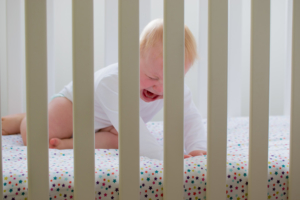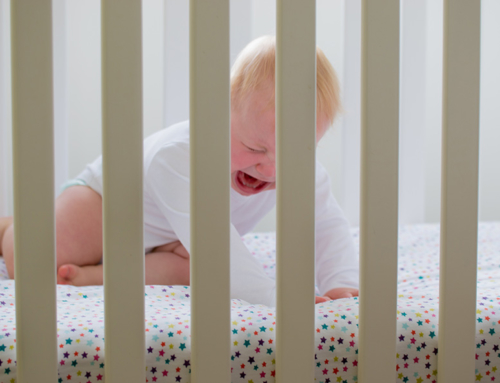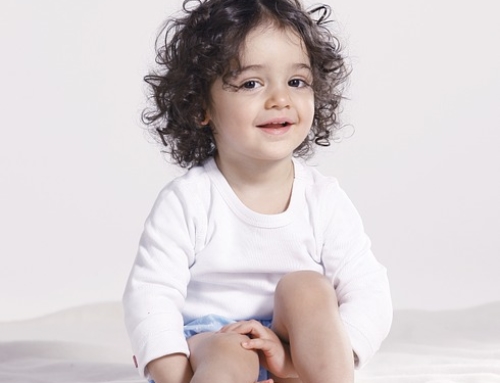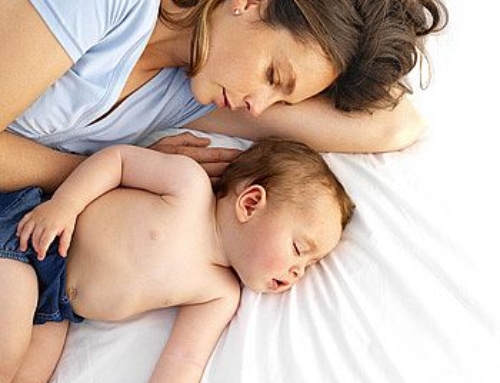
One of the concerns that many families have is that their infant’s sleep – or rather lack thereof – will result in later emotional problems. This, of course, isn’t helped by the narrative given to families by our sleep training culture. Our culture informs us that the negative impact of our children’s sleep will cause long-term problems that many parents hope to avoid and thus take part in the common practice of crying-it-out or the modified controlled-crying.
However, despite findings linking disrupted sleep to certain emotional problems in older children, the evidence to date with younger children is more problematic. In this vein, my goal herein is to discuss two studies that have a bearing on our understanding of the relationship between infant or toddler sleep and later emotional health issues as well as what we can understand about the nature of this relationship.
The Studies and Their Findings (in Brief)
There are two studies I’m aware of that have aimed to address this issue with infant and toddler sleep. The first comes from Dr. Sivertsen and colleagues in Norway and was published in 2015 in JAMA Pediatrics. The study was part of the Norwegian Mother and Child Cohort Study which took place between 1999 and 2008. There were a total of 32,662 dyads included in the current study, providing a very large sample for their examination. Data was collected at 17 weeks gestation (maternal variables), 18 months post-partum and 5 years post-partum. The variables of interest included demographic information, child behaviour and emotional problems (at 18 months and 5 years), and child sleep (18 months). Child behaviour and emotional problems were assessed using the validated Child Behaviour Checklist (which had okay internal validity at 18 months and good validity at 5 years) and child sleep was assessed using parental report of how many hours a child sleeps at night and the number of wakings.
What did they find? At 18 months, 1.9% of the population slept 10 hours or less and 3.2% of the population had 3 or more wakings which were considered the cut-offs for problematic sleep. These values were compared to those children who slept 13 hours or more and who had little to no wakings.
Children at 18 months who slept 10 hours or less or who had 3 or more wakings were more likely to show both internalizing and externalizing problems both concurrently and at 5 years, even when covariates were taken into account. There were also increased risks for those kids sleeping 11-12 hours and who had 1-2 wakings, but the absolute effect was much smaller.
For kids sleeping 10 hours or less, the risk ratio for internalizing problems at 18 months was 3.12 and for externalizing problems was 1.93 after controlling for maternal age, education, duration of pregnancy, parity, birth weight, and sex. At 5 years, the risk ratio was 1.59 for internalizing and 1.77 for externalizing and this is after controlling for everything above and internalizing/externalizing at 18 months. For kids with 3 or more wakings, the risk ratios were 3.19 and 1.69 for internalizing and externalizing at 18 months and 1.57 and 1.25 at 5 years. The conclusions are that sleep problems are concomitant with and precede emotional and behavioural problems in young children and that perhaps targeting sleep would be an appropriate avenue for intervention, though the authors are clear in acknowledging some of the limitations of the study, which I will get to below.
The second study comes from the Murdoch Institute in Australia and was conducted by Dr. Cook and colleagues. The study was also part of a larger cohort study – the Maternal Health Study – and aimed to examine if infant sleep could predict later mental health difficulties at ages 4 and 10 years. There were 1,460 mother-infant dyads included in the study, but data at 10 years was only available for 982 of the dyads. Data was collected at various time points for the various measure of interest; specifically, infant sleep was assessed at 3, 6, 9, and 12 months via parent-report (either questionnaire or structured interview) and mental health was assessed using both the Development and Well-Being Assessment interview which was coded by registered psychologists blind to any other data (aged 10 years), the Strengths and Difficulties Questionnaire, a validated measure for emotional and behavioural problems (ages 4 and 10 years), and the Spence Children’s Anxiety Scale for Parents (aged 10 years).
Children were groups into three sleep groups based on number and frequency of night wakings and maternal report of sleep problems (though the exact manner in which the grouping was done is unclear): settled (i.e., few/no wakings; approximately 24.7% of the entire sample), moderate/fluctuating problems (i.e., some wakings, but not persistent, ebbs and flows; 56% of the entire sample), and persistent problems (i.e., regular wakings across time points; 27.3% of the entire sample). The researchers based all their statistical methods with the settled group as the baseline, and so results are all odds-ratios based on these kids being the “default”.
What did they find? The first piece of information of interest is that the assessment of maternal post-natal depression did find that the mothers of children in the persistent problem group had significantly higher levels of depression than any of the other groups at 12 months post-partum. Although levels were not assessed earlier, it is likely that they also had higher levels earlier as the frequency tends to decline across the first year.
To the main question at hand, what was the relationship between sleep patterns and later emotional functioning accounting for demographic and maternal depression scores? At age 4, there were significant differences between the settled group and the persistent group on emotional symptoms and hyperactivity, with the persistent group having a higher proportion of kids who met the criteria for mental health difficulties (9.4% versus 4.1% for emotional symptoms and 14.4 % versus 8.6% for hyperactivity). Furthermore, there was also a significant difference between the settled and fluctuating group on hyperactivity (13.6% versus 8.6%).
At 10 years of age, there were no differences between the settled and fluctuating groups, but there were two differences between the settled and persistent groups. The first was a difference in proportion of kids in each group who met the criteria for specific increased anxiety symptoms, namely separation anxiety (21.5% versus 10.1%), fear of physical injury (14.7% versus 7.5%), and overall elevated anxiety symptoms (15.6% versus 7.5%). The second was a difference in the proportion of kids in each group who met the criteria for a specific diagnostic criteria for a mental health disorder (parent-report only) in the emotional disorders category only (e.g., anxiety, depression) (15.1% versus 7.4%). Interestingly, there were no differences on the strengths and difficulties questionnaire at age 10 despite that showing differences at age 4.
Thus we have two studies that seem to suggest a lack of consolidated, “settled” sleep is linked to later mood disorders in children and possibly even some behavioural problems as well.
Now let’s take a look at some of the issues that must be considered…
The Problems
I will start by saying that I actually do believe that many of these associations hold, but there are a lot of issues that need to be discussed. The first issue with both studies is that of the third-variable problem. This was something that was directly discussed by Dr. Sivertsen and colleagues in their paper and looks a bit like this: Sleep and behaviour can be causally linked or may be jointly linked through another variable. In some cases, we see certain problems – like marital discord or harsh parenting – predict both emotional/behavioural problems and sleep problems. Thus, the issue isn’t about sleep per se, but about this third variable that may impact both the variables being looked at in the research. In the case of both of these studies there is the strong potential for third variables because really what we have is simply the finding that kids who wake more or sleep less may be at greater risk for childhood anxiety. Some of the possible third variables include, but are not limited to:
- Parenting practices
- Genetics
- Adverse childhood events (which includes marital discord, low socioeconomic status, death of a parent, etc.)
- Health problems
- Developmental delays
The second issue is that of reverse causation. It may not be that there’s a third variable, but rather the anxiety that comes out later first manifests in younger children through sleep. These kids, predisposed or epigenetically ending up higher on anxiety, may struggle with regulation earlier and thus require more parental assistance with sleep. From a common sense perspective, this makes far more sense than sleep disruption leading to greater struggles. However, it then also means that directly affecting sleep won’t actually change the appearance of anxiety.
The third issue is with the assessment of sleep. In both studies, sleep is parent-report and as we know from the research on sleep training, parents aren’t necessarily great at knowing when their kids are actually asleep. In most cases, parents are quite off and kids are sleeping less and waking more than their parents are aware of. This gives credence to the idea that the problems stem from anxiety as these kids may wake the same, but their early anxiety means they require more assistance from caregivers to go back to sleep. A similar argument can be made for the mental health assessments given that there should have been some other valid measure from someone else included, though in cohort data that’s nearly impossible and the measures were valid.
The fourth issue is with the lack of assessment of crucial variables. Understanding child temperament or parenting practices or even sleeping arrangements and nighttime parenting may provide more insight as to what is going on. The lack of assessment of adverse childhood events means we cannot link any later anxiety to these earlier experiences. The fact is that as both of these studies were part of larger cohort studies, the data gathered is incomplete at best, but does serve its purpose to provide initial findings that then need to be expanded upon and replicated.
The fifth issue is with the statistical analyses. The cohorts in both studies have large samples which allows for a greater detection of statistical significance, but the question is if it’s practical significance. For this we also need to look at base rates and effect sizes. Many families reading the write ups of these studies would fear that their wakeful child is going to be damaged, but the baselines for actual problems are very low. In the case of Sivertsen and colleagues, the base rates for these waking behaviours were quite low and although there was an increased risk of emotional/behavioural problems, the risk for age 5 was less than double. In the case of Cook and colleagues, the total number of kids who met the diagnostic criteria for any emotional disorder (based on parent report) was 137 kids and 29 of them were in the persistent problems group as babies whereas 25 of them were in the settled group. Given the total number of kids that were in each group was smaller, the smaller absolute number differences leads to greater proportional differences. This doesn’t mean we ignore it, but it means we have to realize settled sleep certainly doesn’t preclude later problems and the vast majority of kids with so-called “unsettled” sleep end up absolutely fine.
The sixth issue is specific to Cook and colleagues and that is their reference group use. By using the settled group as the reference group, they are making a judgement call, one that I believe is absolutely wrong from all standpoints. For a reference group, researchers should have either a biological basis for what they pick or a normative basis. Sometimes what’s normative isn’t biologically normative and we should go with what’s biologically normal, but in this case, the settled group isn’t normative in any sense of the word. It’s the smallest group proportionally and that type of settled sleep doesn’t match research on patterns of normal infant sleep, meaning it’s not biologically normative. But by using it as the reference group, it’s held up as normal or the ideal (which has implications for sleep training), but also allowed more statistical significance than had they used the actual normative group of the fluctuating sleep patterns. Had they used them, eyeballing the numbers would suggest most (if not all) of their significant findings would disappear. Not quite the same if you write an article about how sleep in infancy doesn’t really change the trajectory of children’s emotional outcomes does it?
The seventh issue is specific to Sivertsen and colleagues and has to do with the behavioural or externalizing findings. This is a case where we actually do have preliminary data that supports the reverse causation hypothesis in that children who are later diagnosed with ADHD are more likely to have reported sleep troubles in infancy using a prospective. This means that the findings with respect to externalizing behaviours may be interacting with other risk factors to create later behavioural issues.
The final issue is the failure to consider the etiology of anxiety or emotional problems and this is linked to that very first third variable problem. Given that the other groups had children with problems later in life, it’s only fair that we consider perhaps that there are different pathways to emotional disturbance. Perhaps for our younger kids who struggle to sleep, their etiology is more genetic, they may be orchids who will struggle with anxiety more in their younger years. Perhaps for our younger kids who sleep well, the etiology has to do with environmental factors. Notably, those environmental factors may be far more modifiable than with the genetic ones, yet our culture’s obsession with sleep leads us to look at everything through the sleep lens. But I ask why these studies haven’t looked at parenting practices instead or ACEs and then argued that the types of emotional disturbances seen with kids who were settled when young, but not when older, could be changed by more responsive caring or systemic changes around them? Wouldn’t that be preferable and have a greater impact than trying to push a sleep training agenda?
Take-Home Message
Yes, there seems to be some relationship between sleep and later emotional disturbances, but there is no evidence that this relationship is causal in terms of sleep being the antecedent and the findings as they have been presented do not support in any way that we should not continue to respond to our babies at night. If anything, perhaps we should be warning parents their kids may be more prone to anxiety and to be more responsive in order to help build that safety net that may lead them to grow up without any comorbid mental health issues. After all, this type of supportive parenting is what is associated with better mental health for our most sensitive children.
____________________________________
References
Armstrong, J. M., Ruttle, P. L., Klein, M. H., Essex, M. J., & Benca, R. M. (2014). Associations of child insomnia, sleep movement, and their persistence with mental health symptoms in childhood and adolescence. Sleep, 37(5), 901-909.
Quach, J. L., Nguyen, C. D., Williams, K. E., & Sciberras, E. (2018). Bidirectional associations between child sleep problems and internalizing and externalizing difficulties from preschool to early adolescence. JAMA pediatrics, 172(2), e174363-e174363.
Sivertsen, B., Harvey, A. G., Reichborn-Kjennerud, T., Torgersen, L., Ystrom, E., & Hysing, M. (2015). Later emotional and behavioral problems associated with sleep problems in toddlers: a longitudinal study. JAMA pediatrics, 169(6), 575-582.
Cook, F., Conway, L. J., Giallo, R., Gartland, D., Sciberras, E., & Brown, S. (2020). Infant sleep and child mental health: a longitudinal investigation. Archives of Disease in Childhood.
Thunström, M. (2002). Severe sleep problems in infancy associated with subsequent development of attention‐deficit/hyperactivity disorder at 5.5 years of age. Acta Paediatrica, 91(5), 584-592.






I think you nailed this article. It’s funny, as I was reading the research you shared towards the top of this post, I was thinking with a few flaws, which you then pointed out in your problems section of this. Thanks for always sharing great research that’s easy to understand!